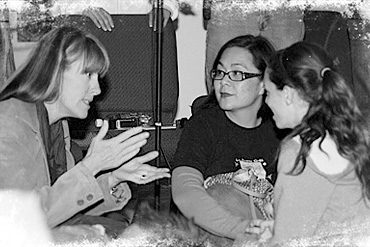
the book of james
The book of James and the gospel of Matthew are the two most Jewish books of the New Testament. Many scholars believe evidence suggests there were actually written versions of these book in either Hebrew or Aramaic that were later translated into Greek. They were certainly written to Jews who shared the same worldview and language of the author. If that’s true, then these books give a uniquely clear view into the teachings of Jesus as his first hearers would have understood them. But we’ll only see through this window clearly if we look with Hebrew eyes. Here’s a look at James through Hebrew eyes.
accepting the ride
James Series 8: In this final session on the book of James, James makes the transition from more commentary on harmful practices and attitudes among those in his community—speaking ill of each other, arrogantly believing one’s own capacity to control circumstances independently of God, swearing—back to prayer and submission to God. And in this transition, he comes full circle from the acceptance of life’s difficulties and challenges with which he began, to the acceptance of our most basic relationship with life.
Read More
falling rules
James Series 7: James continues to hammer on the theme of making our actions match the ends we seek in Kingdom. He points to counter-kingdom practices and action he witnesses in his community—the fights, quarrels, covetousness—and harshly admonishes his people. But again, we need to resist the temptation to just see more rules to follow here. James tells us to draw near to God, humble ourselves, submit, and allow ourselves to let go and descend into a kind of mourning, a sense of loss of all the things we held dear in order to find what is really dear in life.
Read More
starting with heaven
James Series 6: Continuing to develop his theme of the law of liberty, James is determined that we understand how fully becoming the law as Jesus framed it—the fulfilling of law as opposed to mere rule following—was the embodiment of faith. His famous passage about the power of the tongue comparing it to rudders on ships and bits on horses is a colorful way of restating Jesus’ teaching that it’s not what goes into man that defiles him, but what comes out. It’s tempting to see these admonitions as more rules to follow, but James is trying to convey that we must use the same means as the ends we seek.
Read More
law of liberty
James Series 5: James launches into another major theme of his book, the law of liberty. At first glance, his phrase seems to be an oxymoron—joining two completely contradictory terms. Isn’t law the opposite of liberty? But its very definition, law limits and restricts freedom for the greater good of the group. So what is a law of liberty? James speaks of being a doer of the word and not just a hearer, that action is necessary, that hearing without doing is just another way of saying faith without works is dead. James is zeroing in on the essential point that though law as we understand it, restricts, and such law is not what Jesus or James are teaching.
read more
degreeless love
James Series 4: James was Jesus’ brother or close relative or friend—the language of the New Testament can mean any of the above—and perhaps because of such closeness, James teaches in much the same style as Jesus. In the Sermon on the Mount, Jesus begins with the Beatitudes, a picture of the finished product, an end view of the process of kingdom. James also first presents the big, general principles that function the same way. But as does Jesus in the Sermon, James now begins to break down the big concepts into day to day details. How do these principles play out moment by moment?
Read More
full circle
James Series 3: Coming back to the book of James after Christmas and the start of a new year, we are reminded that time, all we know of time, the passage of time, is circular. The only reason we know time is passing is because earth and moon, planets and stars turn in their circles. The movement of circles is the movement of time. Life is circular too—circles within circles, and James’ book, taking us on a journey to define life on Jesus’ Way moves in circles as well. His topics don’t neatly lay out along a straight logical line, but recur in circular patterns. At first glance, it seems chaotic and disordered, but as a metaphor for life, it makes perfect sense.
Read More
the effect of endurance
James Series 2: James tells us in the opening verses of his book that we should count it all joy when we encounter various difficulties because the testing of our faith produces endurance and the endurance produces a perfect result in which we lack for nothing. James then moves on to talk about asking for wisdom, asking without doubt, persevering to reward, the nature of temptation and presence. If we look at these verses from a Western point of view, we will have a complete misunderstanding of what James is saying in his Eastern way to an Eastern audience.
Read More
the beauty of brokenness
James Series 1: James, the brother of Jesus, the man who led the early Jerusalem church for the first thirty years after the crucifixion was the pillar of the Eastern Church and yet is relatively unknown in the West. Western tradition portrays Peter as the head of the early Jewish followers of Jesus, but the East has always maintained James in that position. The book that bears his name was quite possibly a catechism for early Jewish followers and converts and is beautiful in its clarity and brevity and focus on the big questions as well as the essential details of life. Moving nearly verse by verse, we’ll take a look at how James led his brother’s followers through those first difficult years, trying to follow Jesus’ Way through persecution from both Jewish and Roman authorities.



